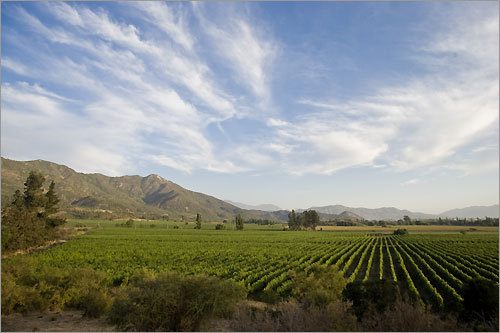So there I am haunting the aisles of the liquor store, about as happy as Marley’s ghost. I need a column and am sorely lacking in inspiration. I ended up talking to one of the staff about what wines he’s been enjoying recently and this segued into a discussion comparing the Chileans and the Americans on the basis of style, and before you know it I was marching out of the store with a couple of hundred dollars’ worth of Cabernet Sauvignon.
[related_content slugs=”the-rise-of-sauvignon-blanc,a-tour-through-the-reds-of-france,chardonnay-all-is-not-lost,the-torrontes-of-spring” description=”More from James Romanow” position=”right”]
If you haven’t been paying attention you may not have noticed the creeping expansion of the Chilean sections of stores. The days of their selling bulk wine cleverly labelled to look like an American wine are long over. Not only are the Chilean wines selling well, they have been pushing up scale, selling a number of wines that are quite expensive.
Their success rests on a couple of pillars. The most important, is that at all price points they over-deliver: While I can think of a handful of wines from elsewhere that should be sold for a third or half the sticker price, I can’t do this with Chile. They have, without much fanfare from us yanqui become an OECD member and a modern nation, something I never expected to see happen in my lifetime. There wine is suitably modern and upscale too.
Like all suppliers I am sure their sweet spot with consumers is around the $15 mark, but above this, and particularly around the $20 mark they make any number of wines that are great values. In particular the Chileans are fond of powerful red wines, particularly those similar in design to Bordeaux. IF your budget can support the extra five bucks, or if you live alone and it takes three days to drink a bottle of red, you really really need to shop this section. Their tannin content keeps them from becoming cough syrup while sitting on the counter, and many of them are actually much better two days old than when freshly opened.
Cabernet Sauvignon has caught the attention of any number of people feeling vaguely dissatisfied by the American product these days. The newer style is a big powerful red, quite thick with a lot of flavour. In the past Chilean wines tended to be quite elegant, but lately they too have been seduced by the newer style. Oaking is present but tends to be less obvious than American cabs – I sometimes only tease the aromas out when pumping the air out of a bottle. These are wines for New World drinkers.
I don’t mind the newer style, although by preference I prefer a lighter bodied red, like a well aged cab sauv. However there is a time and a place for the kind of raw power a sort of NCAA version of the wine that makes perfect sense.
Marques de Casa by Concha y Toro is a particularly old fashioned Cabernet with very hard tannins. With a steak and a potato drenched in olive oil it was drinkable but honestly this one is not for the faint of heart. I tried decanting it, and I’ll likely decant it at least twice next time. It would benefit from 30 seconds or more in the blender if you’re drinking it tonight. Failing that, you can always buy a case and drink it ten years hence.
The wine is extraordinarily aromatic. Iím writing this with an empty glass at my elbow. The drop or two of wine left at the bottom is filling the room with smells of violets and heady fruit.
Max Reserva by Errazuriz is one of my favourite labels. This wine was a direct contrast to the Marques de Casa being clearly made to drink tonight. The tannins are strong enough to survive a few years in the cellar, but the exotic bouquet of coconut and the dark berry fruit palate are enormously inviting. I would think this wine could easily become a favourite wine for any number of cab drinkers.
Lapostolle is a wine made by a family that has the money to do things right (the Marnier clan) and a tremendous history of wine and spirits manufacture. There wines are always solidly made and they have managed to get themselves profiled in any number of publications. All of this is very good for sales, and it has to be admitted that the company knows what theyíre doing.
They kept more of the Old World style than I expected but there is a definite hint of power behind this wine that will probably result in high scores from the British critics and relatively low values from the Americans.
Finally there is La Playa Block Selection Cabernet Sauvignon. La Playa is a label that I think of as exuberant and different, and this wine was exactly that. The bouquet owed considerably more to the grape than the barrel than the other three, with smells of thyme and oregano, and the palate was noticeably leaner than the other four. I imagine this wine will work very well for people of independent taste but if you know you’re a middle of the road cab person, youíve been warned.
Marques de Casa Concha y Toro Cabernet Sauvignon, Chile, 2010. $23.99 ****
Errazuriz Max Reserva Cabernet Sauvignon, Chile, 2010. $21.95 *****
LaPostolle Casa Cabernet Sauvignon, Chile, 2009. $20.08 ****
La Playa Block Selection Reserve Cabernet Sauvignon, Chile, 2010. $23.69 ****
—
James Romanow writes about Wine and all things Boozy for the Spectator Tribune. Follow him @drbooze.
